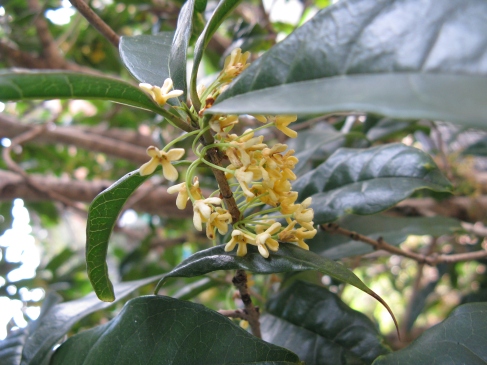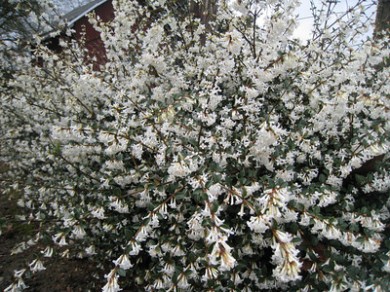
Osmanthus fragrans var. aurantiacus f. thunbergii. KENPEI. Wikimedia Commons.
My long list of Asian early spring bloomers for Southern gardens would be incomplete without this species. Osmanthus is often just a tuck-it-in somewhere bush that sends its fragrance scattering to the four winds, and leaves noses befuddled as to where such a heavenly scent could issue from. The flowers are so small, you could hold a handful of almost a hundred of them, and yet they more than compensate for their size with fragrance. The fragrance is overwhelmingly that of Apricot. Tovah Martin in The Essence of Paradise goes further and says “If you’ve ever indulged in freshly baked apricots swimming in honey, then you might have some inkling as to the intensity of the osmanthus’s nectar.” This is about as accurate as I could ever hope to detail about fragrance, and my nose is in agreeance.
Osmanthus is probably my favorite shrub of all time simply because of the fragrance of the flowers. Its hardy to zone 8, although it can squeak by in zone 7 if under a tall pine or against a warm south wall. The shrub itself is a nice evergreen that does well in part shade, and is an excellent understory plant for woodlands. I wouldn’t hedge them- as they bloom on old-wood, but that is certainly a possible idea for them. They are also good cool-greenhouse plants, but temperamental in windowsills unless you keep your house an even fifty degrees all winter and provide it a good draining medium. They also tend to not fill out well in greenhouses and homes, and are very slow growing- so I would save trying it at home unless you live in a warmer part of the nation and can grow it directly in the ground.
There are also a few other species that are commonly seen in The States, including our native- devilwood, (O. americanus) which I will detail in April when it begins to bloom here. Osmanthus delavayi, O. hetereophyllus, Osmanthus x burkwoodii and Osmanthus x fortunei are also cultivated in the southern tier of the states, but are not as fragrant as O. fragrans and more admired for their visual aesthetic often. They are however hardier, and easier to grow. Osmanthus delavayi can survive temperatures down to zero degrees Fahrenheit and are rarely planted as far north as my home state of Kentucky. This is a late-winter bloomer that knows how to make a show- having the largest flowers of the species (but not the most fragrant sadly.)

Osmanthus delavayi. http://plantmad.blogspot.com.
Most Osmanthus are cool season bloomers. I haven’t heard of any that bloom solely in summer yet- but some cultivars of O. fragrans will have a few sparse flowers in the summer heat. O. fragrans tends to have a long, drawn out show; starting its bloom period with the first cool autumn winds, and ending in late spring. In China and Japan where it is native- they often celebrate its bloom with various autumn festivals, and include it in their diet in the form of tea, liquers, and special cakes made from jam of the boiled down flowers.
I can only imagine deep in the forests of China during autumn how beloved these flowers are. With entire misty forests clouded in the fragrance of an early morning shower and osmanthus, its really no question why the Chinese love this plant so. What other fragrance on earth gives such a euphoria and images of paradise than this? Very few certainly.

March 13, 2014 at 10:01 pm
Love its fragrance!
March 14, 2014 at 7:42 pm
I do too! So lovely 🙂